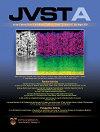等离子体表面相互作用在低k材料蚀刻行为中的意义
IF 2.1
3区 材料科学
Q3 MATERIALS SCIENCE, COATINGS & FILMS
引用次数: 0
摘要
与传统的介电材料(如SiO2)相比,低k材料通过减少寄生电容和在给定厚度下实现更快的器件切换,是半导体器件性能进步中不可或缺的组成部分。随着逻辑标度技术的进步,低k材料在先进器件结构中的作用越来越突出。例如,在场效应晶体管中,低k材料是必不可少的间隔材料,可以提供介电材料之间的蚀刻选择性和电隔离。因此,低k材料的集成需要很好地理解这些材料的蚀刻行为,以便可以可靠地和可重复地制造器件结构。在这项研究中,作者使用了一个高密度等离子体反应器,具有基准的基于CF4和nf3的工艺化学物质,除了Si, SiO2和SiN参考材料外,还蚀刻了低k材料,包括SiCN, SiOCN和SiBCN。许多表征技术被用来了解等离子体条件、材料表面化学的演变以及由此产生的蚀刻行为之间的关系。这些技术包括发射光谱、椭偏光谱、x射线光电子能谱和衰减全反射傅立叶变换红外光谱。在给定的蚀刻工艺下,低k材料的蚀刻行为对于建立多层结构的蚀刻选择性至关重要,而多层结构需要产生复杂的器件几何形状。例如,低k材料的腐蚀速率与本征氮浓度成正比关系。利用模型研究了所观察到的蚀刻行为的潜在机制,并发现低k材料中的固有氮组成可以导致能量有利的反应,从而导致Si-N键的减弱和挥发。确定低k材料蚀刻行为的潜在机制将为将这些材料集成到当前和未来器件结构中的蚀刻工艺的发展提供关键指导。本文章由计算机程序翻译,如有差异,请以英文原文为准。
Significance of plasma-surface interactions in the etch behavior of low-k materials
Low-k materials are an integral component in the advancement of semiconductor device performance by reducing parasitic capacitance and enabling faster device switching for a given thickness compared to traditional dielectric materials such as SiO2. With the advances in logic scaling, low-k materials are increasingly more prominent in the structures of advanced devices. For example, low-k materials are essential as the spacer material to provide both etch selectivity between dielectric materials and electrical isolation in field effect transistors. Consequently, the integration of low-k materials requires that the etch behavior of these materials be well understood so that the device structures can be reliably and reproducibly fabricated. In this study, the authors used a high-density plasma reactor with benchmark CF4- and NF3-based process chemistries to etch low-k materials including SiCN, SiOCN, and SiBCN in addition to Si, SiO2, and SiN reference materials. Numerous characterization techniques were utilized to understand the relationships between the plasma conditions, the evolution of the surface chemistry of the materials, and the resulting etch behavior. These techniques consisted of optical emission spectroscopy, spectroscopic ellipsometry, x-ray photoelectron spectroscopy, and attenuated total reflection Fourier transform infrared spectroscopy. The etch behavior of low-k materials under a given etch process is vital for establishing the etch selectivities in multilayer structures that are required to yield complex device geometries. For example, a directly proportional correlation was observed between the etch rate and intrinsic nitrogen concentration of the low-k materials. Potential mechanisms for the observed etch behaviors were explored using modeling and found that the intrinsic nitrogen composition in the low-k materials can result in energetically favorable reactions that result in the weakening and volatilization of the Si–N bond. Identifying the underlying mechanisms for the etch behaviors of low-k materials will provide key guidance into the development of etch processes that integrate these materials in current and future device structures.
求助全文
通过发布文献求助,成功后即可免费获取论文全文。
去求助
来源期刊

Journal of Vacuum Science & Technology A
工程技术-材料科学:膜
CiteScore
5.10
自引率
10.30%
发文量
247
审稿时长
2.1 months
期刊介绍:
Journal of Vacuum Science & Technology A publishes reports of original research, letters, and review articles that focus on fundamental scientific understanding of interfaces, surfaces, plasmas and thin films and on using this understanding to advance the state-of-the-art in various technological applications.
 求助内容:
求助内容: 应助结果提醒方式:
应助结果提醒方式:


